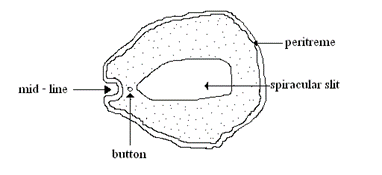การวิเคราะห์ช่วงระยะเวลาหลังการตายโดยใช้หนอนแมลงวัน | Using The Maggots to Analyze The Post Mortem Interval (PMI)
Main Article Content
Abstract
During death investigations, insects are mostly used to estimate the Post Mortem Interval (PMI). These estimates are only as good as they are close to the true PMI (Sharma Ruchi, Rakesh Kumar Garg and J.R.Gaur, 2015). The use of forensic entomology is one of the fastest growing methods used to determine the cause of death and time prediction since death under law enforcement Forensic Science Act (Thai Forensic Act, 2016). The objective of this paper is to analyze and evaluate how forensic entomology is beneficial and used to estimate the period of time. The experiment explores and examines the maggots that are found on a body at the crime scene and then sent to the autopsy room, Maggot samples were collected from the corpse for testing by sectioning the posterior spiracle area of the maggot and then it was taken and looked at under a microscope. From the study, the first and second stage blow fly larvae were found, and it was estimated that this body had been dead for at least 4 - 5 days, which was a time since the death of the Post Mortem Interval (PMI) with the process, (Aballay, Fernando H., M. Cecilia Dominguez, and Florencia Fernandez Campón, 2012) also the decomposition of corpses too (Payne, 1965). Goff (2000) said, “Anyone involved in death investigations quickly becomes aware of the connection between dead bodies and maggots.”. This is very useful for entomologists in estimating mortality as short as possible and as close as possible to the postmortem interval. Forensic Entomology minimum Post Mortem Interval (min PMI). (Matuszewski, 2021)
บทคัดย่อ
การสืบจากศพโดยใช้แมลงเพื่อประมาณค่าช่วงระยะเวลาหลังการตาย (PMI) นั้น มีประโยชน์อย่างยิ่งกับนิติวิทยาศาสตร์ ทำให้ได้ค่าประมาณการหลังตายที่ดีและใกล้เคียงกับ PMI ที่แท้จริง (Sharma Ruchi, Rakesh Kumar Garg and J.R.Gaur, 2015) การใช้นิติกีฏวิทยาเป็นวิธีการหนึ่งในการใช้ศาสตร์ด้านนิติวิทยาศาสตร์ที่มั่นคง ถูกต้อง และรวดเร็วที่สุดในการระบุสาเหตุของการเสียชีวิต การประมาณการช่วงระยะเวลาการเสียชีวิตภายหลังการตายสถาบันนิติวิทยาศาสตร์ปฏิบัติภายใต้พระราชบัญญัตินิติวิทยาศาสตร์ พ.ศ. 2559 (พรบ.นิติวิทยาศาสตร์, 2559) วัตถุประสงค์ของบทความนี้คือเพื่อวิเคราะห์และประเมินระยะเวลาการเสียชีวิต สำรวจ วิจัยและตรวจสอบหนอนแมลงวันที่พบบนร่างศพในที่เกิดเหตุและส่งมายังห้องชันสูตร โดยการเก็บตัวอย่างหนอนแมลงวัน (maggots) จากศพมาทำการตรวจทดลองโดยวิธี section บริเวณ posterior spiracle ของหนอนแมลงวันจากนั้น ก็นำชิ้นส่วนมาส่องดูภายใต้กล้องจุลทรรศน์ จากการศึกษาพบหนอนแมลง (maggots) วันหัวเขียว (blow flies) วัยที่ 1 และวัยที่ 2 และคาดว่าศพนี้ตายมาแล้วไม่น้อยกว่า 4 - 5 วัน ซึ่งเป็นการประมาณการช่วงเวลาการเสียชีวิต (Post Mortem Interval = PMI) (Aballay, Fernando H., M. Cecilia Dominguez, and Florencia Fernandez Campón, 2012) ร่วมกับกระบวนการย่อยสลายของซากศพ (Payne, 1965). ดร.กอฟฟ์ (2000) กล่าวว่า “ใครก็ตามที่เกี่ยวข้องกับห่วงโซ่ของการหาสาเหตุแห่งความตายจะรับรู้ได้อย่างอัตโนมัติถึงความเชื่อมโยงระหว่างศพกับหนอนแมลงวัน” (Goff, 2000). ซึ่งเป็นประโยชน์อย่างมากต่อนักกีฏวิทยาในการประมาณการเสียชีวิตให้สั้นและใกล้เคียงช่วงเวลาภายหลังการตายให้ใกล้เคียงความจริงมากที่สุด Forensic Entomology minimum Post Mortem Interval (min PMI) (Matuszewski, 2021)
Downloads
Article Details
References
Aballay, F. H., Domínguez, M. C., & Fernández Campón, F. (2012). Adult fanniidae associated to pig carcasses during the winter season in a semiarid environment: Initial examination of their potential as complementary PMI indicators. Forensic Science International, 219(1), 284.e1-284.e4. doi: 10.1016/j.forsciint.2011.11.019
Adams Z. J. O. and Hall M. J. R. 2003. Methods used for the killing and preservation
of blowfly larvae and their effect on post-mortem length. Forensic Science International. 138(1-3), 50-61. doi: 10.1016/j.forsciint.2003.08.010.
The American Board of Forensic Entomology.(1996) The ABFE is the certifying Board for Forensic Entomologists in North America. Retrieved August, 30 2022,
from https://forensicentomologist.org/.
Davies L. and Ratcliffe GG. (1994). Development rates of some pre-adult stages in blowflies with reference to low temperatures. Medical and Veterinary Entomology, 8(3), 245–254. doi: 10.1111/j.1365-2915.1994.tb00506.x.
Davis JB and Goff ML. (2000) Decomposition patterns in terrestrial and intertidal habitats on Oahu Island and Coconut Island, Hawaii. Journal of Forensic Sciences, 45(4), 836–842.
Deonier CC. (1940). Carcass temperatures and their relation to winter blowfly populations and activity in the Southwest. Journal of Economic Entomology, 33(1), 166–170.
doi: 10.1093/jee/33.1.166
Dorothy, E. Gennard. (2007). Forensic Entomology: An Introduction (pp.248). United Kingdom: John Wiley & Sons Ltd.
Jason H. Byrd and Jeffery K. Tomberlin. Forensic Entomology: The Utility of Arthropods in Legal Investigations 3rd Edition (pp.575). Australia: Taylor & Francis Group, LLC.
Lee, H.L. (1989). Recovery of Forensically Important Entomological Specimens from Human Cadavers in Malaysia – An Update. Malaysia Journal of Pathology, 11, 33-36.
Lee, G.M. and W.D. Lord. (1994). Entomotoxicology: A new area for forensic investigation. American Journal of Forensic Medicine and Pathology, 15(1), 51-57.
M. Lee Goff. (2000). A Fly for the Prosecution: How Insect Evidence Helps Solve Crimes (pp.240). United States: Harvard University Press
Matuszewski S. (2021). Post-mortem interval estimation based on insect evidence Current Challanges. Science & Justice. 12(4), 314. doi: 10.3390/insects12040314
Nelson Riley C and Karin Gastreich . (2001). Permanently mounting Insects and other small Arthropods on microscope slides. Retrieved August, 30 2022, from https://biology.byu.edu.
Payne JA. (1965). A summer carrion study of the baby pig Sus scrofa Linnaeus. Ecology, 46(5), 592–602.
STEMpedia. (Year). Prepared Microscope Slides: Insects Specimen. Retrieved Retrieved August, 30 2022, from https://thestempedia.com/tutorials/prepared-microscope-slides-insects-specimen/
Rowe, Aaron. (2007). Bugs as Evidence. Law and Order, March, 55(3), 55-56.
Russell, W.C. (1947). Biology of the Dermestid Beetle with Reference to Skull Cleaning. Journal of Mammalogy, 28(3), 284-287.
Saigusa, Kiyoshi, Masataka Takamiya, Masatoshi Matsumasa, and Yasuhiro Aoki. (2006) The Forensic Availability of a Simple and Time Saving Method for the Identification of Dipteran Species to Estimate Postmortem Interval Using Entomological Evidence, (Letter to the Editor). Legal Medicine, 8(4), 203-254. doi: 10.1016/j.legalmed.2006.04.004.
Sharma Ruchi, Rakesh Kumar Garg and J.R.Gaur. (2015) Various methods for the estimation of the post mortem interval from Calliphoridae: A review. Egyptian Journal of Forensic Sciences. 5(1), 1-12. doi:10.1016/j.ejfs.2013.04.002.
Thomas, D.B., and A.C. Chen. (1989). Age Determination in Adult Screw-Worms (Diptera: Calliphoridae) by Pteridine Levels. Journal of Economic Entomology. 82(4), 1140-1144. doi: 10.1093/jee/82.4.1140
Universiti Teknologi MARA (UiTM). (2014). "Blowfly maggots provide physical evidence for forensic cases." ScienceDaily. Retrieved August, 30 2022, from www.sciencedaily.com/rel
eases/2014/09/140903133125.htm.
Zumpt, F. (1965). Myiasis in Man and Animals in the Old World. United Kingdom: Butterworths

